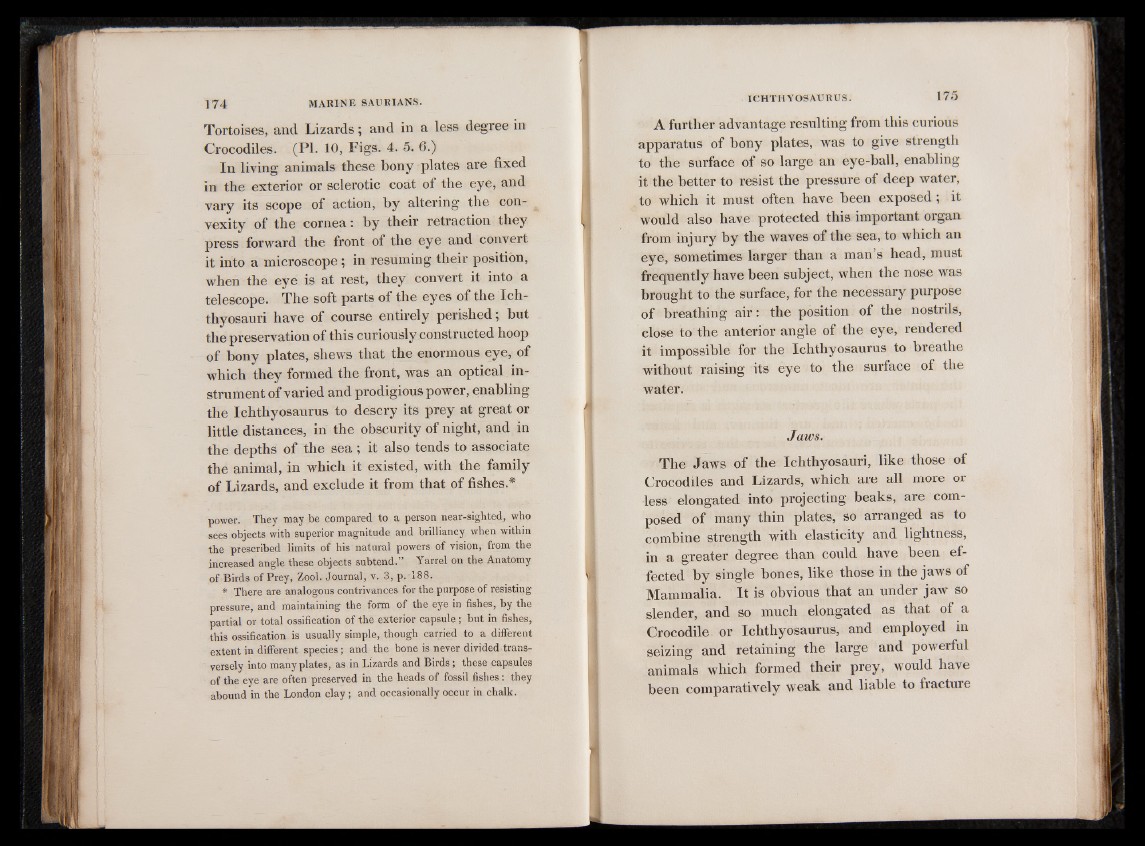
Tortoises, and Lizards; and in a less degree in
Crocodiles. (PI. 10, Figs. 4. 5. 6.)
In living animals these bony plates are fixed
in the exterior or sclerotic coat of the eye, and
vary its scope of action, by altering the con- _
vexity of the cornea: by their retraction they
press forward the front of the eye and convert
it into a microscope ; in resuming their position,
when the eye is at rest, they convert it into a
telescope. The soft parts of the eyes of the Ichthyosauri
have of course entirely perished; but
the preservation of this curiously constructed hoop
of bony plates, shews that the enormous eye, of
which they formed the front, was an optical instrument
of varied and prodigious power, enabling
the Ichthyosaurus to descry its prey at great or
little distances, in the obscurity of night, and in
the depths of the sea ; it also tends to associate
the animal, in which it existed, with the family
of Lizards, and exclude it from that of fishes.*
power. They may be compared to a person near-sighted, who
sees objects with superior magnitude and brilliancy when within
the prescribed limits of his natural powers of vision, from the
increased angle these objects subtend.” Yarrel on the Anatomy
of Birds of Prey, Zool. Journal, v. 3, p. 188.
* There are analogous contrivances for the purpose of resisting
pressure, and maintaining the form of the eye in fishes, by the
partial or total ossification of the exterior capsule; but in fishes,
this ossification is usually simple, though carried to a different
extent in different species; and the bone is never divided transversely
into many plates, as in Lizards and Birds; these capsules
of the eye are often preserved in the heads of fossil fishes: they
abound in the London c la y ; and occasionally occur in chalk.
A further advantage resulting from this curious
apparatus of bony plates, was to give strength
to the surface of so large an eye-ball, enabling
it the better to resist the pressure of deep water,
to which it must often have been exposed ; it
would also have protected this important organ
from injury by the waves of the sea, to which an
eye, sometimes larger than a man’s head, must
frequently have been subject, when the nose was
brought to the surface, for the necessary purpose
of breathing a ir: the position of the nostrils,
close to the anterior angle of the eye, rendered
it impossible for the Ichthyosaurus to breathe
without raising its eye to the surface of the
water.
Jaws.
The Jaws of the Ichthyosauri, like those of
Crocodiles and Lizards, which are all more or
less elongated into projecting beaks, are composed
of many thin plates, so arranged as to
combine strength with elasticity and lightness,
in a greater degree than could have been effected
by single bones, like those in the jaws of
Mammalia. It is obvious that an under jaw so
slender, and so much elongated as that of a
Crocodile or Ichthyosaurus, and employed in
seizing and retaining the large and powerful
animals which formed their prey, would have
been comparatively weak and liable to fracture